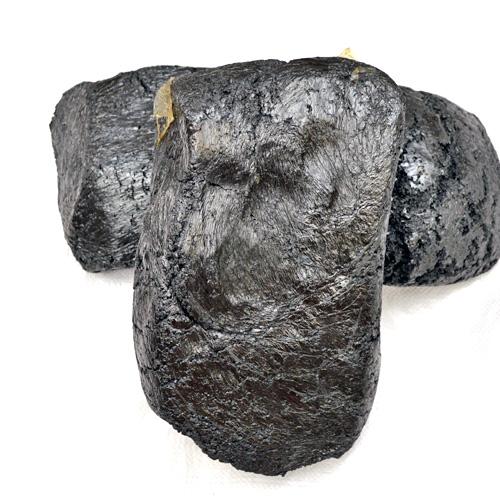
Anhydrous tap hole mix for blast furnace tap hole
Anhydrous tap hole mix for blast furnace
Anhydrous tap hole mix adopts the technology of raw material homogenization and micropowder pre-mixing, and uses special composite raw materials as admixtures. It has good corrosion resistance, filling and sintering properties, and has a forced repair function for iron cracks. The mouth quickly produces a certain ability to resist mechanical and chemical damage, and the high temperature strength has a good bond with the residual mud, and it is easy to open when tapping and ensures that the molten iron and slag pass quickly. The erosion is small, which is the flow of molten iron and slag. It is stable and smooth, thus inhibiting the circulation of slag and molten iron in the furnace, reducing the damage of the lining bricks on the bottom side of the furnace around the tap hole, well protecting the furnace lining and hearth in the tap hole area of the blast furnace, and being beneficial to the extension of the blast furnace. Furnace life.
|
Project |
index |
|||
|
PN-1 |
PN-2 |
PN-3 |
||
|
Al2O3%≥ |
20 |
25 |
30 |
|
|
SiC+C%≥ |
30 |
30 |
30 |
|
|
Bulk density(g/cm3) |
1350℃×3h |
≥1.65 |
≥1.70 |
≥1.80 |
|
Heating permanent wire change rate% |
-1.5~+1.5 |
-1.5~+1.5 |
-1.5~+1.5 |
|
|
Cold compressive strength/MPa≥ |
≥8.0 |
≥10 |
≥15 |
|
|
Recommended for blast furnace type |
1000m3 |
1000m3~2500m3 |
2500m3min |
|
Advantages of anhydrous taphole clay for blast furnace taphole:
1. It is easy to play mud, and the pass rate of the depth of the iron mouth is more than 98%.
2. Quick-drying, quick-hardening performance, high strength, short withdrawal time.
3. Easy to open, the one-time opening rate reaches more than 98%, which can prevent the crack of the mud hole.
4. The mud bag in the shape of mushroom head can be formed in the hearth, which is beneficial to protect the hearth and the furnace wall.
5. Good corrosion resistance to slag iron, erosion resistance, slow hole reaming and long tapping time.
6. The product is environmentally friendly and non-polluting, and has no physical harm to the operator, improving the working environment in front of the furnace.
Refractory wet mud used to block the iron outlet can be divided into two categories: water cannon mud and waterless gun mud. On large and medium -sized blast furnaces on high top pressure and high degree of smelting.
Refractory ramming mass (refractory taphole mass) is a kind of Refractory used for lining of blast furnace tapping groove. It is mainly used to protect the blast furnace out of the ditch from high-temperature hot metal and slag erosion and erosion, and has excellent high-temperature resistance and wear resistance. The ramming material for the iron discharge ditch is usually composed of corundum, silicon carbide and carbonaceous material, which has the ability of resisting hot metal and molten slag erosion and scouring, reburning line change small, strong resistance to a variety of oxidation characteristics. The construction of the ramming material for the iron ditch is convenient, easy to dismantle and repair, does not produce harmful gas, and is beneficial to environmental protection.
In the blast furnace smelting process, blast furnace taphole clay, as a key plastic material, plays a vital role. This article will introduce in detail the product characteristics, working principle and innovation of blast furnace taphole clay in improving furnace stability and production efficiency.
Anhydrous taphole mud/taphole clay refers to taphole mud made of tar, resin, etc. as binders and corundum, bauxite, clay, silicon carbide, coke powder, etc. as raw materials. Anhydrous carbon taphole mud is made by a mud mill. When rolling, oil is added first, then block materials (clay and asphalt), and then powder materials (coke powder and clinker powder) are added after crushing. After pressing and mixing, the mud can be produced when it meets the standards.
We specialize in producing various types of tap hole clay. Our tap hole clay protects the blast furnace hearth, increases production and saves costs! We are your best choice for tap hole clay suppliers.
high alumina refractory bricks is mainly used around the furnace cover, electrode holes and exhaust holes of electric furnaces, and its service life is 1 to 2 times longer than that of silica bricks.
Coke furnace silicon bricks are mainly used in the heat storage room, oblique road, charcoal room, combustion room, top of the furnace, and bottom of the furnace.
High alumina refractory bricks are the backbone of high-temperature industrial processes. By understanding their properties, applications, and supplier selection criteria, businesses can enhance operational efficiency and reduce downtime. For industries seeking durable, cost-effective solutions, partnering with certified refractory materials suppliers in China ensures access to cutting-edge technology and reliable supply chains.



